英国文学 上册 大作品赏析汇总
英美文学名著与电影赏析

《英美文学名著和电影赏析》期末课程测试《简·爱》名著和电影赏析姓名: 闫法轲学校:中原工学院信息商务学院专业: 会计班级: Z会计121学号: 2一.作品综述1.作者简介:夏洛蒂·勃朗特(Charlotte Bronte,1816-1855)1816年生于英国北部约克郡的豪渥斯的一个乡村牧师家庭。
母亲早逝,八岁的夏洛蒂被送进一所专收神职人员孤女的慈善性机构——柯文桥女子寄宿学校。
在那里,她的两个姐姐玛丽亚和伊丽莎白因染上肺病而先后死去。
于是夏洛蒂和妹妹艾米莉回到家乡,15岁时她进了伍勒小姐办的学校读书,几年后又在这个学校当老师。
后来她曾作家庭教师,最终她投身于文学创作的道路。
夏洛蒂·勃朗特有两个姐姐、两个妹妹和一个弟弟。
两个妹妹,即艾米莉·勃朗特和安恩·勃朗特,也是著名作家,因而在英国文学史上常有“勃朗特三姐妹”之称。
1847年,夏洛蒂·勃朗特出版著名的长篇小说《简·爱》,轰动文坛。
1848年秋到1849年她的弟弟和两个妹妹相继去世。
在死亡的阴影和困惑下,她坚持完成了《谢利》一书,寄托了她对妹妹艾米莉的哀思,并描写了英国早期自发的工人运动。
她另有作品《维莱特》(1853)和《教师》(1857),其中《维莱特》可以看做是她个人的小说体自传,和她的人生经历十分相似。
这两部作品均根据其本人生活经历写成。
夏洛蒂·勃朗特善于以抒情的笔法描写自然景物,作品具有浓厚的感情色彩。
这位天生体弱的女作家是十九世纪英国文坛上一颗璀璨的明珠。
2.主要情节概述:这本小说是一部具有浓厚浪漫主义色彩的现实主义小说。
主要描写了简·爱的一系列遭遇以及和罗切斯特的爱情经历。
主人公简·爱是一个心地纯洁、善于思考的女性,她生活在社会底层,受尽磨难。
但是她有倔强的性格和勇于追求平等幸福的精神。
小说以浓郁抒情的笔法和深刻细腻的心理描写,引人入胜地展示了男女主人公曲折起伏的爱情经历,歌颂了摆脱一切旧习俗和偏见。
英国文学作品赏析——萨克雷《名利场》的叙述策略
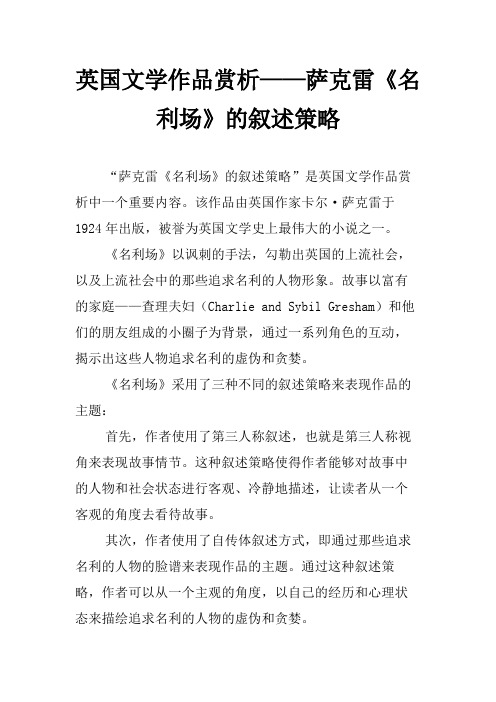
英国文学作品赏析——萨克雷《名利场》的叙述策略
“萨克雷《名利场》的叙述策略”是英国文学作品赏析中一个重要内容。
该作品由英国作家卡尔·萨克雷于1924年出版,被誉为英国文学史上最伟大的小说之一。
《名利场》以讽刺的手法,勾勒出英国的上流社会,以及上流社会中的那些追求名利的人物形象。
故事以富有的家庭——查理夫妇(Charlie and Sybil Gresham)和他们的朋友组成的小圈子为背景,通过一系列角色的互动,揭示出这些人物追求名利的虚伪和贪婪。
《名利场》采用了三种不同的叙述策略来表现作品的主题:
首先,作者使用了第三人称叙述,也就是第三人称视角来表现故事情节。
这种叙述策略使得作者能够对故事中的人物和社会状态进行客观、冷静地描述,让读者从一个客观的角度去看待故事。
其次,作者使用了自传体叙述方式,即通过那些追求名利的人物的脸谱来表现作品的主题。
通过这种叙述策略,作者可以从一个主观的角度,以自己的经历和心理状态来描绘追求名利的人物的虚伪和贪婪。
再次,萨克雷在《名利场》中还采用了第一人称叙述的方式,也就是由主人公自己来讲述故事。
这种叙述策略可以让读者更好地感受到主人公的情感和思考,从而更好地理解作品的主题。
《名利场》是一部宏大的小说,作者萨克雷采用了三种叙述策略——第三人称叙述,自传体叙述和第一人称叙述,用以表现作品的主题——追求名利的虚伪和贪婪。
这种叙述策略使这部作品变得特别有趣,令人耳目一新,既能让读者从客观的角度理解故事,又能从主观的角度更好地理解主人公的情感和思考。
英国文学Iwonderedlonelyasacloud的赏析整
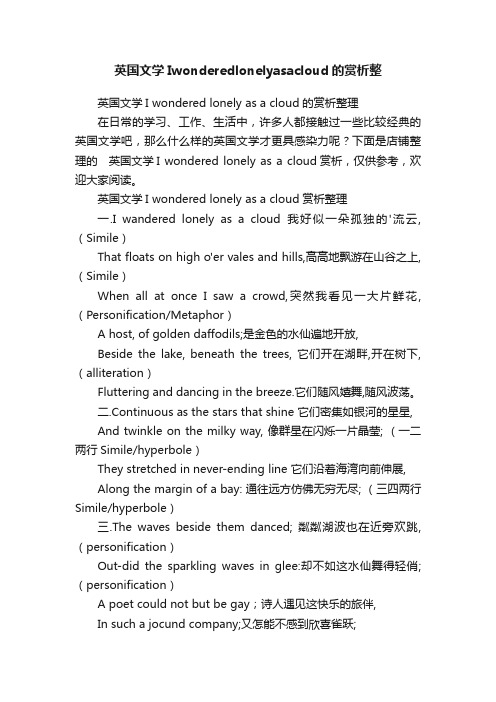
英国文学Iwonderedlonelyasacloud的赏析整英国文学I wondered lonely as a cloud的赏析整理在日常的学习、工作、生活中,许多人都接触过一些比较经典的英国文学吧,那么什么样的英国文学才更具感染力呢?下面是店铺整理的英国文学I wondered lonely as a cloud赏析,仅供参考,欢迎大家阅读。
英国文学I wondered lonely as a cloud赏析整理一.I wandered lonely as a cloud我好似一朵孤独的'流云,(Simile)That floats on high o'er vales and hills,高高地飘游在山谷之上, (Simile)When all at once I saw a crowd,突然我看见一大片鲜花, (Personification/Metaphor)A host, of golden daffodils;是金色的水仙遍地开放,Beside the lake, beneath the trees, 它们开在湖畔,开在树下,(alliteration)Fluttering and dancing in the breeze.它们随风嬉舞,随风波荡。
二.Continuous as the stars that shine 它们密集如银河的星星,And twinkle on the milky way, 像群星在闪烁一片晶莹; (一二两行Simile/hyperbole)They stretched in never-ending line 它们沿着海湾向前伸展,Along the margin of a bay: 通往远方仿佛无穷无尽; (三四两行Simile/hyperbole)三.The waves beside them danced; 粼粼湖波也在近旁欢跳, (personification)Out-did the sparkling waves in glee:却不如这水仙舞得轻俏; (personification)A poet could not but be gay;诗人遇见这快乐的旅伴,In such a jocund company;又怎能不感到欣喜雀跃;I gazed—and gazed—but little thought.我久久凝视——却未领悟What wealth the show to me had brought:...这景象所给我的精神之宝。
[英国文学作品]英国文学
![[英国文学作品]英国文学](https://img.taocdn.com/s3/m/d32b940017fc700abb68a98271fe910ef12dae45.png)
[英国文学作品]英国文学英国文学篇(1):10部英国经典小说10. 《名利场》Vanity Fair (William Makepeace Thackeray, 1848)威廉·梅克皮斯·萨克雷,1848年出版这部小说的主角或许就是英国文学史上最知名的非正统派女主角——贝奇·夏普,小说的情节围绕阶级、社会、跻身上流社会以及现代读者听来又熟悉又害怕的金融危机。
《名利场》这些要素全都具备, 讲述那个年代,也讲述着每一个年代。
9. 《科学怪人》Frankenstein (Mary Shelley, 1818)玛莉·雪莱,1818年出版这部先锋作品集科幻和哥特式恐怖于一身,营造了一个难以磨灭的“恶魔”主题,即科学家中的“现代普罗米修斯”,几世纪以来经久不衰。
8. 《大卫·科波菲尔》David Copperfield (Charles Dickens, 1850)查尔斯·狄更斯,1850年出版David Copperfield is populated by some of the most vivid characters ever created. They are as much a part of readers’ world, and their way of thinking about the world, as people they have actually met.《大卫·科波菲尔》人物形象众多,性格鲜活的角色云集。
这些人物角色仿佛是读者所在真实世界的一部分,和读者亲身遇见的人一样,有着相似的世界观。
7. 《呼啸山庄》Wuthering Heights (Emily Bront, 1847)艾米莉·勃朗特,1847年出版《呼啸山庄》“蕴含巨大的心理能量,没有其它书籍能够与之匹敌。
”读者推崇《呼啸山庄》是因为其“层层叠叠的叙述结构”和丰富惊人的想象力,更因为《呼啸山庄》超越了爱情故事本身,展现了我们转瞬即逝的欲望之下“永恒的震撼”。
英国文学诗歌赏析

Ode to the west 雪莱西风颂查良铮译1哦,狂暴的西风,秋之生命的呼吸!你无形,但枯死的落叶被你横扫,有如鬼魅碰到了巫师,纷纷逃避:黄的,黑的,灰的,红得像患肺痨,呵,重染疫疠的一群:西风呵,是你以车驾把有翼的种子催送到黑暗的冬床上,它们就躺在那里,像是墓中的死穴,冰冷,深藏,低贱,直等到春天,你碧空的姊妹吹起她的喇叭,在沉睡的大地上响遍,(唤出嫩芽,像羊群一样,觅食空中)将色和香充满了山峰和平原。
不羁的精灵呵,你无处不远行;破坏者兼保护者:听吧,你且聆听!2没入你的急流,当高空一片混乱,流云象大地的枯叶一样被撕扯脱离天空和海洋的纠缠的枝干。
成为雨和电的使者:它们飘落在你的磅礴之气的蔚蓝的波面,有如狂女的飘扬的头发在闪烁,从天穹的最遥远而模糊的边沿直抵九霄的中天,到处都在摇曳欲来雷雨的卷发,对濒死的一年你唱出了葬歌,而这密集的黑夜将成为它广大墓陵的一座圆顶,里面正有你的万钧之力的凝结;那是你的浑然之气,从它会迸涌黑色的雨,冰雹和火焰:哦,你听!3是你,你将蓝色的地中海唤醒,而它曾经昏睡了一整个夏天,被澄澈水流的回旋催眠入梦,就在巴亚海湾的一个浮石岛边,它梦见了古老的宫殿和楼阁在水天辉映的波影里抖颤,而且都生满青苔、开满花朵,那芬芳真迷人欲醉!呵,为了给你让一条路,大西洋的汹涌的浪波把自己向两边劈开,而深在渊底那海洋中的花草和泥污的森林虽然枝叶扶疏,却没有精力;听到你的声音,它们已吓得发青:一边颤栗,一边自动萎缩:哦,你听!4哎,假如我是一片枯叶被你浮起,假如我是能和你飞跑的云雾,是一个波浪,和你的威力同喘息,假如我分有你的脉搏,仅仅不如你那么自由,哦,无法约束的生命!假如我能像在少年时,凌风而舞便成了你的伴侣,悠游天空(因为呵,那时候,要想追你上云霄,似乎并非梦幻),我就不致像如今这样焦躁地要和你争相祈祷。
哦,举起我吧,当我是水波、树叶、浮云!我跌在生活底荆棘上,我流血了!这被岁月的重轭所制服的生命原是和你一样:骄傲、轻捷而不驯。
英国诗歌赏析
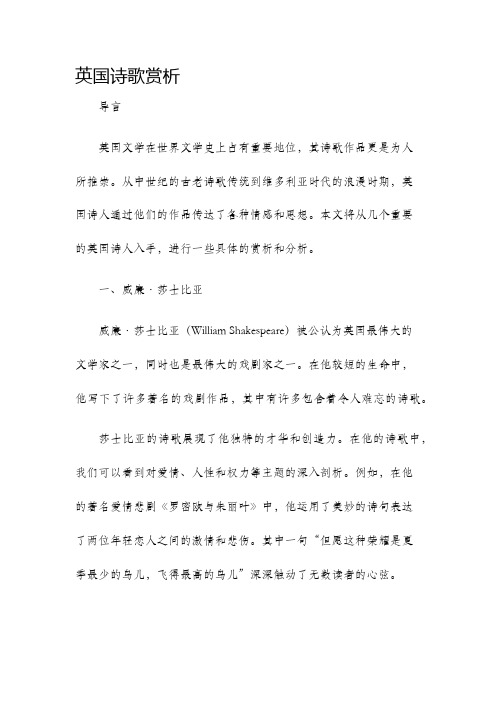
英国诗歌赏析导言英国文学在世界文学史上占有重要地位,其诗歌作品更是为人所推崇。
从中世纪的古老诗歌传统到维多利亚时代的浪漫时期,英国诗人通过他们的作品传达了各种情感和思想。
本文将从几个重要的英国诗人入手,进行一些具体的赏析和分析。
一、威廉·莎士比亚威廉·莎士比亚(William Shakespeare)被公认为英国最伟大的文学家之一,同时也是最伟大的戏剧家之一。
在他较短的生命中,他写下了许多著名的戏剧作品,其中有许多包含着令人难忘的诗歌。
莎士比亚的诗歌展现了他独特的才华和创造力。
在他的诗歌中,我们可以看到对爱情、人性和权力等主题的深入剖析。
例如,在他的著名爱情悲剧《罗密欧与朱丽叶》中,他运用了美妙的诗句表达了两位年轻恋人之间的激情和悲伤。
其中一句“但愿这种荣耀是夏季最少的鸟儿,飞得最高的鸟儿”深深触动了无数读者的心弦。
莎士比亚的诗歌才华使他的作品经久不衰,并成为世界各地戏剧演员和诗歌爱好者的珍藏。
二、约翰·基茨约翰·基茨(John Keats)是浪漫主义时期的杰出诗人之一。
他的诗歌以其优美的形象、深情和富有感知力的文字而闻名。
基茨的诗歌表达了对自然、艺术和爱情的热情。
他的一首著名诗歌《秋夜长诗》描述了一个富有画面感的秋天夜晚。
他通过细腻的描写和富有感情的语言,让读者真切地感受到了秋天的美丽与温暖。
基茨的诗歌作品也探讨了许多深刻的主题,例如生死、时间和美的本质。
他的作品常常将寻找内心世界与对外部世界的观察和体验相结合,给人留下深刻的印象。
三、威廉·华兹华斯威廉·华兹华斯(William Wordsworth)是著名的浪漫主义诗人,也被誉为英国浪漫主义诗歌运动的领袖之一。
他的诗歌作品被誉为具有启发性和敏感性的杰作。
华兹华斯的诗歌作品主要表达了对自然和人类内心的关注。
他强调人与自然之间的亲密关系,并倡导人们回归大自然和内心的平静与安宁。
他的著名诗歌《世界太多吵闹》以诗人的视角观察现实世界,描述了城市生活的嘈杂和丛林中的宁静。
英国文学英语赏析1
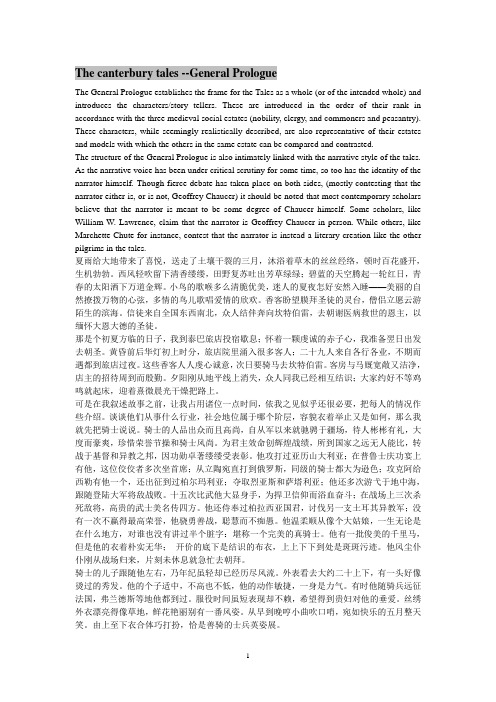
The canterbury tales --General PrologueThe General Prologue establishes the frame for the Tales as a whole (or of the intended whole) and introduces the characters/story tellers. These are introduced in the order of their rank in accordance with the three medieval social estates (nobility, clergy, and commoners and peasantry). These characters, while seemingly realistically described, are also representative of their estates and models with which the others in the same estate can be compared and contrasted.The structure of the General Prologue is also intimately linked with the narrative style of the tales. As the narrative voice has been under critical scrutiny for some time, so too has the identity of the narrator himself. Though fierce debate has taken place on both sides, (mostly contesting that the narrator either is, or is not, Geoffrey Chaucer) it should be noted that most contemporary scholars believe that the narrator is meant to be some degree of Chaucer himself. Some scholars, like William W. Lawrence, claim that the narrator is Geoffrey Chaucer in person. While others, like Marchette Chute for instance, contest that the narrator is instead a literary creation like the other pilgrims in the tales.夏雨给大地带来了喜悦,送走了土壤干裂的三月,沐浴着草木的丝丝经络,顿时百花盛开,生机勃勃。
英美文学赏析
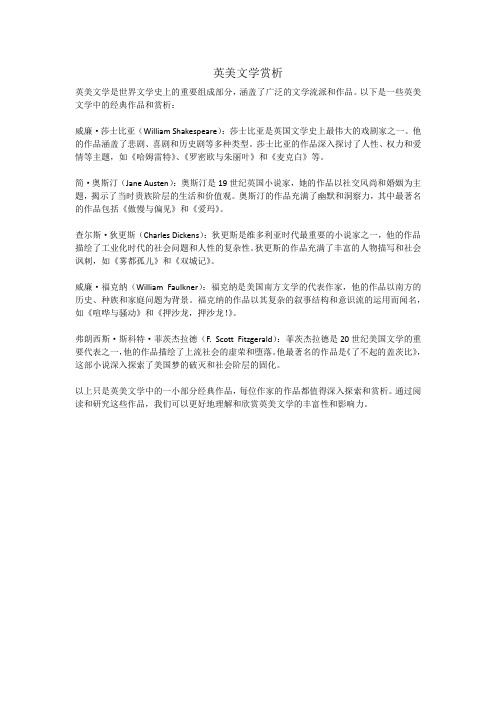
英美文学赏析英美文学是世界文学史上的重要组成部分,涵盖了广泛的文学流派和作品。
以下是一些英美文学中的经典作品和赏析:威廉·莎士比亚(William Shakespeare):莎士比亚是英国文学史上最伟大的戏剧家之一。
他的作品涵盖了悲剧、喜剧和历史剧等多种类型。
莎士比亚的作品深入探讨了人性、权力和爱情等主题,如《哈姆雷特》、《罗密欧与朱丽叶》和《麦克白》等。
简·奥斯汀(Jane Austen):奥斯汀是19世纪英国小说家,她的作品以社交风尚和婚姻为主题,揭示了当时贵族阶层的生活和价值观。
奥斯汀的作品充满了幽默和洞察力,其中最著名的作品包括《傲慢与偏见》和《爱玛》。
查尔斯·狄更斯(Charles Dickens):狄更斯是维多利亚时代最重要的小说家之一,他的作品描绘了工业化时代的社会问题和人性的复杂性。
狄更斯的作品充满了丰富的人物描写和社会讽刺,如《雾都孤儿》和《双城记》。
威廉·福克纳(William Faulkner):福克纳是美国南方文学的代表作家,他的作品以南方的历史、种族和家庭问题为背景。
福克纳的作品以其复杂的叙事结构和意识流的运用而闻名,如《喧哗与骚动》和《押沙龙,押沙龙!》。
弗朗西斯·斯科特·菲茨杰拉德(F. Scott Fitzgerald):菲茨杰拉德是20世纪美国文学的重要代表之一,他的作品描绘了上流社会的虚荣和堕落。
他最著名的作品是《了不起的盖茨比》,这部小说深入探索了美国梦的破灭和社会阶层的固化。
以上只是英美文学中的一小部分经典作品,每位作家的作品都值得深入探索和赏析。
通过阅读和研究这些作品,我们可以更好地理解和欣赏英美文学的丰富性和影响力。
英美文学经典作品赏析与研究
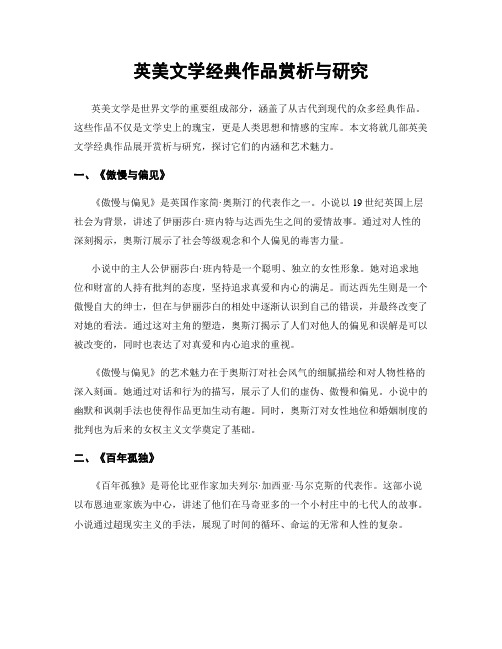
英美文学经典作品赏析与研究英美文学是世界文学的重要组成部分,涵盖了从古代到现代的众多经典作品。
这些作品不仅是文学史上的瑰宝,更是人类思想和情感的宝库。
本文将就几部英美文学经典作品展开赏析与研究,探讨它们的内涵和艺术魅力。
一、《傲慢与偏见》《傲慢与偏见》是英国作家简·奥斯汀的代表作之一。
小说以19世纪英国上层社会为背景,讲述了伊丽莎白·班内特与达西先生之间的爱情故事。
通过对人性的深刻揭示,奥斯汀展示了社会等级观念和个人偏见的毒害力量。
小说中的主人公伊丽莎白·班内特是一个聪明、独立的女性形象。
她对追求地位和财富的人持有批判的态度,坚持追求真爱和内心的满足。
而达西先生则是一个傲慢自大的绅士,但在与伊丽莎白的相处中逐渐认识到自己的错误,并最终改变了对她的看法。
通过这对主角的塑造,奥斯汀揭示了人们对他人的偏见和误解是可以被改变的,同时也表达了对真爱和内心追求的重视。
《傲慢与偏见》的艺术魅力在于奥斯汀对社会风气的细腻描绘和对人物性格的深入刻画。
她通过对话和行为的描写,展示了人们的虚伪、傲慢和偏见。
小说中的幽默和讽刺手法也使得作品更加生动有趣。
同时,奥斯汀对女性地位和婚姻制度的批判也为后来的女权主义文学奠定了基础。
二、《百年孤独》《百年孤独》是哥伦比亚作家加夫列尔·加西亚·马尔克斯的代表作。
这部小说以布恩迪亚家族为中心,讲述了他们在马奇亚多的一个小村庄中的七代人的故事。
小说通过超现实主义的手法,展现了时间的循环、命运的无常和人性的复杂。
小说中的布恩迪亚家族经历了无数的悲剧和荣耀。
他们的命运似乎被注定要经历一系列的重复和循环,而无法逃脱。
马尔克斯通过对家族成员的描写,反映了人类的孤独和渺小感,同时也表达了对命运和历史的思考。
《百年孤独》的艺术魅力在于马尔克斯对语言和形式的创新。
他运用了超现实主义的手法,将奇幻和现实融合在一起,创造出一个独特的文学世界。
小说中的细节描写和丰富的象征意义也使得作品具有了深度和厚度。
英美文学作品赏析

作家与作品:海明威:·《非洲的青山》·《太阳照常升起》·《战地钟声》·《永别了,武器》·《第五纵队·西班牙大地》·《曙光示真》·《不固定的圣节》·《过河入林》·《丧钟为谁而鸣》·《危险的夏天》·《老人与海》·《伊甸园》·《丧钟为谁而鸣》·《非洲的青山》·《死在午后》·《岛在湾流中》·《有钱人和没钱》.菲茨杰拉德:《人间天堂》,《了不起的盖茨比》《夜色温柔》(1934)和《最后一个巨商》。
·维吉尼亚•伍尔芙(1882—1941)英国著名小说家、批评家维吉尼亚•伍尔芙也是一位著名的意识流作家和意识流小说的奠基者。
1919年,伍尔芙发表了第一部意识流小说《墙上的斑点》。
《达罗卫夫人》(1925)、《到灯塔去》(1927)是伍尔芙意识流小说的代表作。
纳撒尼尔·霍桑1804~1864)美国小说家,是美国19世纪影响最大的浪漫主义小说家和心理小说家。
《范肖》(1828)《古宅青苔》(1843)、《雪影》(1851)<红字>《带有七个尖角阁的房子》《玉石雕像》.杰克伦敦:杰克·伦敦是著名的美国小说家,他一生共创作了约50卷作品,其中最为著名的有《荒野的呼唤》、《海狼》、《白牙》、《马丁·伊登》和短篇小说《老头子同盟》、《北方的奥德赛》、《马普希的房子》等.华兹华斯:早期诗歌《晚步》《素描集》,从《抒情歌谣集》开始一反18世纪的诗风,将一种崭新的风格带到诗歌创作中,开创了英国文学史上浪漫主义诗歌的新时代。
《不朽的征兆》由《序曲》《漫游》两部分组成的哲理性长诗《隐者》等。
1843年被封为英国“桂冠诗人”.威廉.布雷克To see a world in a grain of sand, 从一粒沙子看到一个世界,And a heaven in a wild flower, 从一朵野花看到一个天堂,Hold infinity in the palm of your hand, 把握在你手心里的就是无限,And eternity in an hour. 永恒也就消融于一个时辰。
英美文学的经典名著赏析
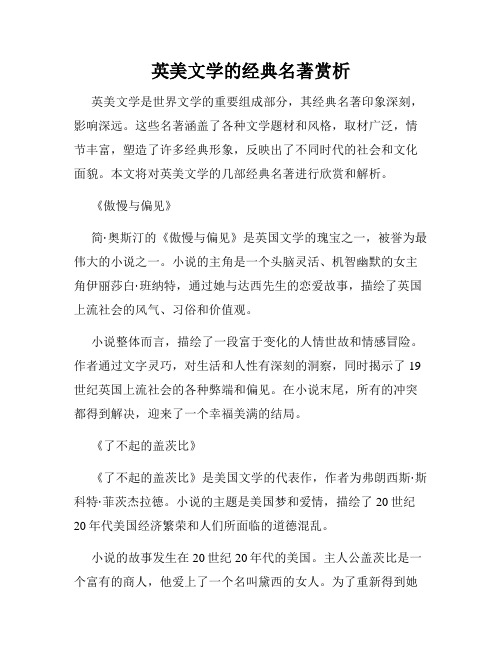
英美文学的经典名著赏析英美文学是世界文学的重要组成部分,其经典名著印象深刻,影响深远。
这些名著涵盖了各种文学题材和风格,取材广泛,情节丰富,塑造了许多经典形象,反映出了不同时代的社会和文化面貌。
本文将对英美文学的几部经典名著进行欣赏和解析。
《傲慢与偏见》简·奥斯汀的《傲慢与偏见》是英国文学的瑰宝之一,被誉为最伟大的小说之一。
小说的主角是一个头脑灵活、机智幽默的女主角伊丽莎白·班纳特,通过她与达西先生的恋爱故事,描绘了英国上流社会的风气、习俗和价值观。
小说整体而言,描绘了一段富于变化的人情世故和情感冒险。
作者通过文字灵巧,对生活和人性有深刻的洞察,同时揭示了19世纪英国上流社会的各种弊端和偏见。
在小说末尾,所有的冲突都得到解决,迎来了一个幸福美满的结局。
《了不起的盖茨比》《了不起的盖茨比》是美国文学的代表作,作者为弗朗西斯·斯科特·菲茨杰拉德。
小说的主题是美国梦和爱情,描绘了20世纪20年代美国经济繁荣和人们所面临的道德混乱。
小说的故事发生在20世纪20年代的美国。
主人公盖茨比是一个富有的商人,他爱上了一个名叫黛西的女人。
为了重新得到她的心,他开始沉迷于一系列疯狂的聚会和放荡的生活,最终以悲剧收场。
小说通过对爱情和道德的思考,阐述了美国社会在经济发展的同时所遭受的文化和道德的挣扎。
同时,小说对人物形象和环境描写也有极高的艺术价值。
《了不起的盖茨比》向人们展示了一个充满矛盾和冲突的时代。
《百年孤独》《百年孤独》是哥伦比亚文学家加西亚·马尔克斯的代表作品。
以哥伦比亚的马孔多镇为背景,小说反映了拉丁美洲的历史和文化。
小说的故事贯穿了百年时间,讲述了布恩迪亚家族的兴衰和命运,集中展现了该地区彼此交错的历史与文化趋势。
作者以幽默、夸张、超现实的手法,勾勒出了神秘的信仰、优美的爱情、荒唐的命运以及糟糕的历史。
《百年孤独》堪称文学史上的经典之作,它打破了传统文学的束缚,用全新的视角展示了哥伦比亚的多元风格和东海岸上的戏剧般的传奇。
大学英国文学重点诗歌及选文赏析

诗歌赏析1) 诗名 2) 作者 3) 赏析a. 结构:共几节——每节几行+韵律b. 文化背景:从何而来+主题【精神+意识】c. 常用修辞:如metaphor (隐喻)d. Personification (拟人)e. Parallelism (排比)f. 小节内容:如“以某物(意象)烘托出……情感/意境”g. 主旨Sonnet 18——William ShakespeareQuatrainⅠ:a :Shall I compare thee to a summer's day?b :a :b :QuatrainⅠ:c :d :And often is his gold complexion dimm'd;c :d :Quatrain Ⅰ:e :f :e :f :Couplet :g :So long as men can breathe or eyes can see, g :So long lives this, and this gives life to thee. 我可能把你和夏天相比拟? 你比夏天更可爱更温和: 狂风会把五月的花苞吹落地, 夏天也嫌太短促,匆匆而过; 有时太阳照得太热,常常又遮暗他的金色的脸;美的事物总不免要凋落,偶然的,或是随自然变化而流转。
但是你的永恒之夏不会褪色; 你不会失去你的俊美的仪容;死神不能夸说你在他的阴影里面走着,如果你在这不朽的诗句里获得了永生;只要人们能呼吸,眼睛能看东西,此诗就会不朽,使你永久生存下去。
It’s a typical English or Shakespeare sonnet. The major feature of this poem is analogy.By putting his love’s beauty into the form of poetry, the poet is preserving it forever by the power of his written words.Literature will keep transient beauty ever lasting./ Power of artA. Structure1. Sonnet 18 can be divided into four parts: three quatrains and a couplet.The first quatrain is from line 1 to line 4, the second from line 5 to line 8, and the third from line 9 to line 12. The couplet is the group of last two lines.2. The rhyme scheme of sonnet 18 is ABAB CDCD EFEF GG.Sonnet 18 contains 14 lines. The ends of line 1 and line 3 have the end rhyme /ei/, line 2 and line 4 rhyme with /eit/. And these four lines form the first quatrain. The line 5 and line 7 have the end rhyme/ /, while line 6 and line 8 have the same form is used in line 9 and line 11 and line 10 and line 2, which end with the rhyme /eid/ and /ost/. However, the last two lines have their own end rhyme which is /i:/.3. Sonnet 18 is iambic pentameter.Each line of Sonnet 18 has five feet with an unaccented syllable followed by an accented syllable.Examples are as follow:“Shall I / compare/ thee to / a sum / mer’s day?” has accents on”shall”, “com”,”thee”,”a, mer”respectively.“Thou art/ more love / ly and/ more tem / perate”has accents on”thou”, “more”, “ly”, “more”,”pe” respectively.B. Language use1. Several kinds of rhetoric are used.Metaphor: “The eye of heaven”means the sun.Simile: “Shall I compare thee to a summer's day?” uses simile to compare the loved to a summer’s day.Personification:”his gold complexion” personates the summer’s day and”shake the darling buds”uses “shake” to personate the rough winds.Inversion: “And every fair form fair sometimes declines can be in the order likethis:”And every fair sometime declines from fair”“By chance, or nature's changing course intrimme'd” can be in the order like this: “untrimmed by chance or nature's changing course”2. Images”A summer's day” means the season of summer.“Day” means a period of time.“Lease”means allotted time.“The eye of heaven” means sun.“His its” means sun.“Fair”means something beautiful.“This” means this poem.C. Appreciation1. Shakespeare compares his friend to a summer’s day. From line 1 to line 8, then he pays attention to praise his friend’s permanence, while from line 9 to line 14, and his focus is shifted towards expressing that poetry is immortal.2. Sonnet 18’s first line asks a question: how can I compare you to a summer's day? Line 2 answers the question that the loved one is more gentle and lovely.From line 4 to line 8, poet says summer is too short. And sometimes it will shine too much and can be burning while sometimes it will be dimmed when cloudy or overcast. All the beautiful things will finally lose their perfection for nature’s change and instability.From line9 to line14, poet starts praising an eternal beauty. This beauty is the beloved one and also the poems, and it is the poems make the loved everlasting.3.The theme of sonnet 18 is that love is the only thing that can conquer all the things in the world and the beauty is the immortal thing that can never be replaced.Song ”Go and Catch A Falling Star ”——John DonneGo and catch a falling star, Get with child a mandrake root, Tell me where all past years are, Or who cleft the Devil's foot, Teach me to hear mermaids' singing, Or to keep off envy's stinging, And find What windServes to advance an honest mindIf thou beest born to strange sights, Things invisible to see,Ride ten thousand days and nights, Till age snow white hairs on thee, Thou, when thou return'st, wilt tell me All strange wonders that befell thee, And swear No whereLives a woman true, and fair.If thou find'st one,let me know, Such a pilgrimage were sweet; Yet do not, I would not go, Though at next door we might meet; Though she were true when you met her, and last till you write your letter, Yet she Will beFalse, ere i come, to two, or three.Rhyme: abab cc ddd + Conceit 奇喻1.This poem chiefly concerns the lack of constancy in women. The tone taken is one of gentle cynicism and mocking.2. John Donne has lost his naive views of love. His confidence in the power of love has been waned and now he appears more cautiousand almost bitter.3. The title, "Song", leads us to expect certain things: a lyrical element to the words, and a musical rhythm, which are fulfilled by this neatly crafted poem. It is also very ambiguous, not hinting at the subject matter of the poem.4. Each stanza is nine lines, it allows for the more complex and abstract ideas, which are archetypal of metaphysical poetry.The first stanza is the most forceful, employing the imperative to achieve a sense of command, and implying that he is talking to one specific person.The second stanza is full of convoluted images and hyperbole; it is as if Donne is mocking the idea of a love poem in itself.The final stanza begins in a sardonic manner.5.He appears to be expressing the opinion that a woman of character and beauty is implausible.Form and Structure1.However this naïve rhyme does add to the phonological quality of the poem, as the simplicity is perhaps more songlike than the rest of the poem.2.The regular rhyme and meter of the poem also help to create this feeling. There is a very tight verse structure, which consists ofa sestet of ABAB rhyme preceding the rhyming triplet in each stanza.3.The triplet shows an insistence of opinion,it emphasises the points being made but also creates a lilting rhythm to the end of each verse, like the refrain to a song.4.The two very short lines immediately precede a farlonger one, thus creating contrast, which mirrors the contrasting images in the poem.I Wandered Lonely as a Cloud——William WordsworthA host, of goldenContinuous as the stars that shine And twinkle on the milky way, They stretched in never -ending line Along the margin of a bay: Ten thousand saw I at a glance, Tossing their heads in sprightly dance.The waves beside them danced; but they Out -did the sparkling waves in glee: A poet could not but be gay, In such a jocund company:I gazed ---and gazed ---but little thought What wealth the show to me had brought:For oft, when on my couch I lie In vacant or in pensive mood, They flash upon that inward eye Which is the bliss of solitude;And then my heart with pleasure fills, And dances with the daffodils .1. The definition of poetry:Poetry is “the spontaneous overflow of powerful feelings, which originates in emotion recollected in tranquility.” 2. The Function of poetry:The poetry is to give an unexpected splend or to familiar and commonplace things, to incidents and situations from common life. 3. The themes of his poetry:➢ beauty of nature + rural life + harmony between human and natureComposition and ThemeThe four six-line stanzas of this poem follow a quatrain-couplet rhyme scheme: ABAB CC. Each line is metered in iambic tetrameter.Like most works by Wordsworth, it is romantic in nature; the beauty of nature, unkempt by humanity, and a reconciliation of man with his environment, are two of the fundamental principles of the romantic movement within poetry.The plot of the poem is simple. Wordsworth believed it "an elementary feeling and simple impression".ConclusionThis poem was written by William Wordsworth, the representative poet of the early romanticism. It consists of four six-line stanzas, in iambic tetrameter and an ABAB CC rhyme scheme. At the beginning of the poem, Wordsworth compares himself to a cloud, enjoying freedom but suffering from loneliness. But the sight of a cloud of dancing daffodils makes him drunk. What's more, it brings him great courage to face depression and loneliness in the following days. Here, the daffodils is the nature. All the time,his poems concentrate on the relationship between human and nature. As William Wordsworth believed, nature can have greet healing power effect on the mind.Daffodils: symbolize living a life as rich in experience and sensation as would make a life worth living.Ode on a Grecian Urn——John KeatsThou still unravish’d bride of quietness, 你委身“寂静”的、完美的处子,Thou foster-child of Silence and slow Time, 受过了“沉默”和“悠久”的抚育,Sylvan historian, who canst thus express 呵,田园的史家,A flowery tale more sweetly than our rhyme: 你竟能铺叙一个如花的故事,比诗还瑰丽:What leaf-fringed legend haunts about thy shape 在你的形体上,岂非缭绕着古老的传说,以绿叶为其边缘;Of deities or mortals, or of both, 讲着人,或神,In Tempe or the dales of Arcady? 敦陂或阿卡狄?What men or gods are these? What maidens loth? 呵,是怎样的人,或神!What mad pursuit? What struggle to escape? 在舞乐前多热烈的追求!少女怎样地逃躲!What pipes and timbrels? What wild ecstasy? 怎样的风笛和鼓谣!怎样的狂喜!Heard melodies are sweet, but those unheard 听见的乐声虽好,但若听不见却更美;Are sweeter; therefore, ye soft pipes, play on; 所以,吹吧,柔情的风笛;Not to the sensual ear, but, more endear'd, 不是奏给耳朵听,而是更甜,Pipe to the spirit ditties of no tone: 它给灵魂奏出无声的乐曲;Fair youth, beneath the trees, thou canst not leave 树下的美少年呵,你无法中断你的歌,Thy song, nor ever can those trees be bare; 那树木也落不了叶子;Bold Lover, never, never canst thou kiss, 鲁莽的恋人,你永远、永远吻不上,Though winning near the goal—yet, do not grieve; 虽然够接近了——但不必心酸;She cannot fade, though thou hast not thy bliss, 她不会老,虽然你不能如愿以偿,For ever wilt thou love, and she be fair! 你将永远爱下去,她也永远秀丽!Ah, happy, happy boughs! that cannot shed 呵,幸福的树木!Your leaves, nor ever bid the spring adieu; 你的枝叶不会剥落,从不曾离开春天;And, happy melodist, unwearied, 幸福的吹笛人也不会停歇,For ever piping songs for ever new; 他的歌曲永远是那么新鲜;More happy love! more happy, happy love! 呵,更为幸福的、幸福的爱!For ever warm and still to be enjoy'd, 永远热烈,正等待情人宴飨,For ever panting, and for ever young: 永远热情地心跳,永远年轻:All breathing human passion far above, 幸福的是这一切超凡的情态,That leaves a heart high-sorrowful and cloy'd, 它不会使心灵餍足和悲伤,A burning forehead, and a parching tongue. 没有炽热的头脑,焦渴的嘴唇。
英美文学赏析英国文学部分

英国文学史资料British Writers and Works一.Anglo-Saxon period<Beowulf> 贝奥武夫:the national epic of the Anglo-SaxonsEpic:long narrative poems that record the adventures or heroic deeds of a hero enacted in vast landscapes. The style of epic is grand andelevated. ( 主题严肃,语言庄重)e.g. Homer ’s Iliad and OdysseyArtistic features:ing alliteration( 押头韵)(该文最大修辞特点,每行第一个词辅音韵)Definition of alliteration: a rhetorical device, meaning somewords in a sentence begin with the same consonant sound (辅音)ing metaphor (暗喻,隐喻)and understatementDefinition of understatement: expressing something in acontrolled way Understatement is a typical way for Englishmen toexpress their ideas二.The Middle Ages (Medieval Ages )Geoffery Chaucer 杰弗里?乔叟1340(?)~1400(首创“双韵体”,英国文学史上首先用伦敦方言写作。
约翰·德莱顿(John Dryden )称其为“英国诗歌之父”The father of English poetry.first time to use ‘heroic couplet ’(英雄双韵体) by middle English代表作《坎特伯雷故事集》《The Canterbury tales 》。
英国文学作品赏析
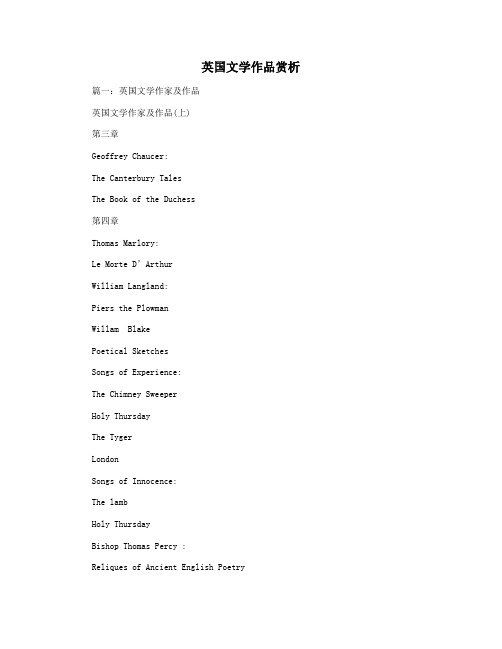
英国文学作品赏析篇一:英国文学作家及作品英国文学作家及作品(上)第三章Geoffrey Chaucer:The Canterbury TalesThe Book of the Duchess第四章Thomas Marlory:Le Morte D’ArthurWilliam Langland:Piers the PlowmanWillam BlakePoetical SketchesSongs of Experience:The Chimney SweeperHoly ThursdayThe TygerLondonSongs of Innocence:The lambHoly ThursdayBishop Thomas Percy :Reliques of Ancient English PoetryProfessor F.J. Child:English and Scottish BalladsSir Thomas Malory :Le Morte d’Arthur, or The Death of Arthur 第五章Edmund Spenser:The Shephearde’s CalenderThe Faerie QueeneA View of the Present State of IrelandChristopher Marlowe:King Richard ⅢTamburlaine the GreatThe Tragic History of Doctor FaustusWilliam Shakespeare:Venus and AndonisThe Rape of LucreceKing HeyⅥ,RichardⅢTwo Gentlemen of VeronaLove’s Labour LostMidsummer Night’s Dre amRomeo and JulietThe Merchant of VeniceHeyⅣHeyⅤAs You Like ItJulius CaesarHamletOthelloKing LearMacbethWinter’s TaleThe TempestWilliam Blake:Poetical SketchesSongs of InnocenceSongs of ExperienceThe Chiminey Sweeper and Holy Thursday Prophetic Books第六章Francis Bacon:Of Great Place,Of Studies.John Donne:Song,The Canonization,A Valediction:Forbidding Mouring.George Herbert:The templeBen Jonson:Comedies of HumoursJohn Milton:L’Allegro (The Cheerful Man),Il Penseroso (The Pensive Man),The Tenure of Kings and Magistrares ),Defemsop pro Populo Anglicano (The Defence of the English People), Paradise Lost,Genesis.John Bunyan:The Pilgim’s Progress,Celestial City.John Dryden:An Essay of Dramatic Poesy,Every Man in his Hummor,Sejanus and Catiline,Discoveries,Richard Brinsley Sheriden:The RivalA Trip To ScarboroughRobert Burns:Is There For Honest PovertyPublius Cornelius Tacitus:GermaniaVenerable Bede:The Ecclesiatical History of the English People第七章Daniel Defoe:The Shortest Way with the DissentersHymn to the PolloryRobinson CrusoeCaptain SingletonMoll FlandersA Journal of the Plagure YearColonel JackRoxanaA General History of Trade and The Complete English Tradesman The Life and Strange Surprising Adventures of Robinson Cursoe The Fortunes and Misfortunes of the Famous Moll FlandersJonathan Swife:The Battle of BooksA Tale of the TubThe Drapier’s LettersA Modest ProposalGulliver’s TravelsRobert Burns:Is There for Honest PovertyScots, Wha HaeAuld Lang SyneA Red, Red RoseJohn Addison:The TatlerThe SpectatorGuardianThomas Gray:The Elegy Written in a Country Churchyard Alexander Pope:PastoralsAn Essay on CriticismThe Rape of the LockIliad and OdysseyThree Hours After MarriageThe DunciadAn Essay on ManImitations of HoraceRichard Brinsley Sheridan:A Trip to SarboroughThe School for ScandalSamuel Johnson:The RamblerThe AdventurerThe IdlerLord ChesterfieldDictionaryWilliam Blacke:Songs of InnocenceSongs of ExperienceHey Fielding:The Historical Register for the Year 1736The ChampionThe Convent Garden JournalTrue PatriotJacobite”s JournalJoseph AndrewsJonathan Wild the GreatTom Jones and AmeliaAn Apology for the Life of Mrs.Shamela AndrewsThe History of the Adventures of Joseph AndrewsThe History of Tom Jones英国文学作家及作品(下)第八章Rousseau:The New HeloiseEmileEdmund Burke:Reflection on the Revolution in FranceA Philosophical Enquiry into the Origin of Our Ideas of the Sublime and the BeautifulAristotle:The PoeticsLonginus:On the SublimeThomas Paine:The Right of ManWilliam Wordsworth:The RecluseLyrical BalladsSamuel Taylor Coleridge:The Rime of the Ancient MarinerKubla KhanLyrical BalladsBiographia LiterariaGeorge Gordon Byron:English Bards and Scotch ReviewersChilde Harold’s PilgrimageOriental Tales篇二:英国文学作品The Song of Beowulf 贝奥武甫Beowulf Hygelac Hrothgar Grendel Grendel' s MotherHamlet 哈姆雷特Hamlet Horatio Ophelia Claudius GertrudePoloniusLaertes Merchant of Venice 威尼斯商人ShylockAntonioBassanioPortiaParadise Lost 失乐园Satan Adam and Eve GodThe History of Tom Jones, a Foundling 弃婴汤姆琼斯的故事 Tom Jones Blifil Sophia WsternThe Vicar of Wakefield 威克菲尔德的牧师Dr. PrimroseOlivia and SophiaSquire ThornhillGeorgeMr. BurchellSir William ThornhillThe School for Scandal 造谣学校Charles SurfaceJoseph SurfacePride and Prejudice 傲慢与偏见Jane Bennet Charles Bingley Mr. BennetMrs. BennetGeorge Wickham Lydia Bennet Mr. Collins Miss Bingley Lady Catherine Mr. and Mrs. GardinerGeorgiana Darcy Mary Bennet Catherine Bennet Elizabeth Bennet Fitzwilliam Darcy Jane BennetCharles BingleyOliver Twist雾都孤儿Oliver Twist FaginBill SikesArtful Doger,Mr. BrownlowMonksMrs. Maylie RoseNancyVanity Fair 名利场Amelia Sedley Rebecca (Becky) Sharp Joseph Sir Pitt Crawley Rawdon Crawley George Osborne Captain Dobbin Napoleon Dobbin Lord SteyneJane Eyre 简・爱Jane EyreMrs. ReedMr. RochesterRev. RiversWuthering Heights 呼啸山庄Hindley Earnshaw Hareton Catharine Earnshaw Cathy Edgar Linton Isabella Linton Sick son Linton HeathcliffMy Last Duchess:我已故的公爵夫人 Duke of FerraraTess of the D’ Urbervilles 德伯家的苔丝Tess D' Urberville Alec Angel Clare,篇三:英国文学文学作家及作品汇总12345感谢您的阅读,祝您生活愉快。
英国文学I-wondered-lonely-as-a-cloud赏析整理
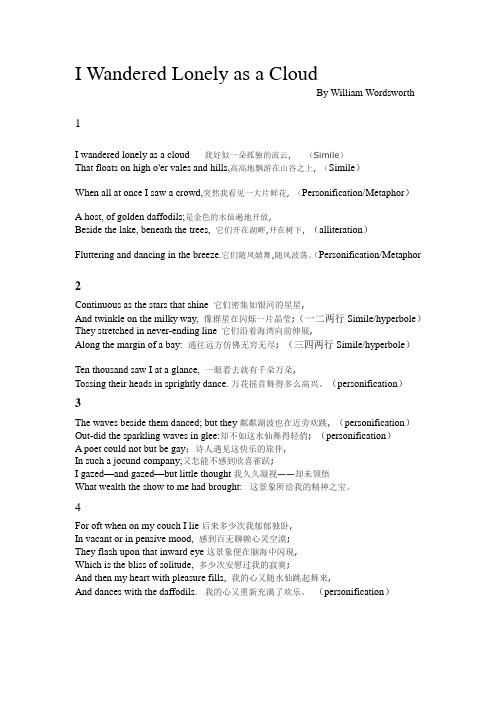
I Wandered Lonely as a CloudBy William Wordsworth1I wandered lonely as a cloud 我好似一朵孤独的流云, (Simile)That floats on high o'er vales and hills,高高地飘游在山谷之上, (Simile)When all at once I saw a crowd,突然我看见一大片鲜花, (Personification/Metaphor)A host, of golden daffodils;是金色的水仙遍地开放,Beside the lake, beneath the trees, 它们开在湖畔,开在树下, (alliteration)Fluttering and dancing in the breeze.它们随风嬉舞,随风波荡。
(Personification/Metaphor2Continuous as the stars that shine 它们密集如银河的星星,And twinkle on the milky way, 像群星在闪烁一片晶莹; (一二两行Simile/hyperbole)They stretched in never-ending line 它们沿着海湾向前伸展,Along the margin of a bay: 通往远方仿佛无穷无尽; (三四两行Simile/hyperbole)Ten thousand saw I at a glance, 一眼看去就有千朵万朵,Tossing their heads in sprightly dance..万花摇首舞得多么高兴。
(personification)3The waves beside them danced; but they粼粼湖波也在近旁欢跳, (personification)Out-did the sparkling waves in glee:却不如这水仙舞得轻俏; (personification)A poet could not but be gay;诗人遇见这快乐的旅伴,In such a jocund company;又怎能不感到欣喜雀跃;I gazed—and gazed—but little thought我久久凝视——却未领悟What wealth the show to me had brought:...这景象所给我的精神之宝。
英国文学赏析整理

Alexander PopeAn Essay on Man (know then thyself)The poem is written in iambic tetrameter, every two line have the same thyme at the last word.The poem is important in the sense that it embodies the 18th century concepts of the universe and man’s place in it, that is man is made in the shape of God, and occupies a middle position in the Great Chain of Being. As the poet says sometimes we have too much knowledge and feel suspect about everything, but sometimes we have too much weakness and can not be as pride as Stotic, sometimes we seem to have the power to rule all things but sometimes we seem prey to all. We are in the middle place and sometimes we are confused about whether to act or rest. The poet perfectly describes man’s feeling about ourselves and about the world.Although Pope is never profound in thought but he is very adapt in voicing the idea of his contemporaries in a beautiful and clever way.Robert BurnsA Red, Red, RoseThe metrical pattern of the poem is basically in the ballad form, i.e. each stanza consisting of four lines, with four stressed syllables in the odd-numbered lines and three stressed syllables in the even-numbered lines, and with rhymes occurring on the even-numbered lines.The image of rose evokes traditional associations of beauty, love and romance. Its simple lyrics and straight form and expression of feeling make it a favorite choice for poetry anthologies and a most appreciated poem for readers. Incorporating various elements from folk songs, the poem is supposed to be a song sung by an Irish sailor to his sweet heart before his ship sailed off to sea, the exaggerated declaration of love “till theseas are gone dry and till the rock melts” can remind us of a well known Chinese oath. There is no tearful parting. But determined hope of reunion: the sailor will come back to his sweet heart” though it were ten thousand miles.”William BlakeThe LameThe poem is written in rhyming couplets with alternating iambic and anapestic feet. it’s one of the poems that collected in Songs of Innocence which express the poet’s delight in life, even in the face of sorrow and suffering.The poem is a child song, in the form of a question and answer. The first stanza is rural and descriptive, while the second focuses on abstract spiritual matters and contains explanation and analogy. The child’s question is both na?ve and profound. “who made thee” is a simple question, but the child is also tapping into the deep and timeless questions that all human beings have, about their own origins and the nature of creation. The situation of a child talking to an animal is a believable one. Yet by answering his own question the child coverts it into a rhetorical one, thus counteraction the initial spontaneous sense of the poem, and also reveals his confidence in his simple Christian faith and his innocent acceptance of its teachings.The lamb symbolizes Jesus, as Jesus has a traditional image as a lamb. The image of the child is also associated with Jesus: in the Gospel, Jesus displays a special concern for children. This poem, like many of the poems in Songs of Innocence, accepts that Blake saw as the most positive aspects of conventional Christian belief.William WordsworthI wandered lonely as a cloud(四步抑扬)The form of the poem: it consists of four six-line stanzas following the rhyme scheme: ababcc. Each line is metered (音步) in iambic tetrameter.One of the themes of the poem is about the soothing effect of memories on human thoughts, as we know the song was written 2 years later when Wordsworth saw the flowers, so memories are really important.It’s a typical poem of Romanticism; it incorporates the ideas and aspects that are essential in romantic poetry. This simple poem also revisits the familiar subject of the unity between human and nature in a simple style and musical eloquence.The poem’s main brilliance lies in the reverse personification in its early stanzas. The speaker is metaphorically compared to a natural subject—a cloud, and the daffodils are continually personified as human beings, dancing and tossing their heads. This technique is a very effective method for instilling in the reader the similar feeling, by which words worth implies an inherent unity between man and nature and signs of the harmony between things in nature and the harmony between nature and the poet himself.The Solitary Reaper(四步抑扬)The four eight-line stanzas of this poem are written in a tight iambic tetrameter. Each follows a rhyme scheme of ababccdd.In this poem, the beauty of the song is presented to the reader through two well organized comparisons in the second stanza.The poem’s structure: the first stanza sets the scene, the second offers two bird comparisons for the music, the third wonders about the content of the songs, and the fourth describes the effect of the songs on the speaker. The final two lines of the poem return its focus to the familiar theme of memory and the soothing effect of beautiful memories on human thoughts and feelingsTo an extent, this poem ponders the limitations of language, as it does in the third stanza, but the ultimate intention of the poem is to praise the beauty of music and its fluid expressive beauty.George Gordon ByronShe Walks in Beauty (四步抑扬)The poem contains three stanzas of iambic tetrameter, with an unaccented syllable followed by an accented syllable. Its rhyme scheme: abababByron wrote the poem for his young cousin when they first met at a party, at that time she was wearing a black gown and Byron was struck by her beauty.In the poem, the first two lines demonstrate both the opposing qualities of darkness and light that pass through the three verses[(诗或歌的)句, 节.].By reading the poem, the reader can look deeper into the contents of Byron’s poem and discover both internal and external beauty in the lady.Don Juan (the isles of Greece) (四步抑扬)The poem is composed of 16stanzas, each stanza consisting of 6 lines of iambic tetrameter, with a rhyme scheme of ababcc.It’s a satirical epic and also Byron’s masterpiece. It consists of 16 cantos(长诗中的篇章) and remains unfinished.Don Juan was a great epic of the early 19th century, it was a time when Turkish people took control of Greece and brought the dreadful life to Greek people. European writers and scholars are mostly keen on the ancient Greek civilization, and Byron is also one of them, but he is more interested in calling upon the Greek people to rise up against their enslavement under the Turkish rule.Byron’s poems are full of revolutionary enthusiasm. The Isles of Greece portrays perfectly this character of spirit. In the poem, he speaks in the voice of a Greek poet, as he use expressions like “my country” and he writes about the past glories of Greece with the purpose of motivating the present-day Greeks to fight for freedom.Although the poem is about the adventures of a Spanish libertine(浪子), the real significance of the poem lies in the vivid description of the lives and manners of many lands, Byron’s fiery passions for the liberation of the Greek people and his bitter satire on the sham(假装) and hypocrisy(虚伪) in love, religion, and the social relations of his time.唐璜是一步未完成的长篇叙事讽刺诗,是拜伦最长的作品,《哀希腊》为六行诗体,四音步抑扬格,韵式为ababcc。
英国文学重点作品赏析[1]
![英国文学重点作品赏析[1]](https://img.taocdn.com/s3/m/a3eae5788e9951e79b8927ad.png)
Hamlet is the first work of literature to look squarely at the stupidity, falsity and sham of everyday life, without laughing and without easy answers. In a world where things are not as they seem, Hamlet…s genuineness, thoughtfulness, and sincerity make him special.Hamlet is no saint. But unlike most of the other characters (and most people today), Hamlet chooses not to compromise with evil. Dying, Hamlet reaffirms the tragic dignity of a basically decent person in a bad worldHamlet is the first work of literature to show an ordinary person looking at the futility and wrongs in life, asking the toughest questions and coming up with honest semi-answers like most people do today.Unlike so much of popular culture today, "Hamlet" leaves us with the message that life is indeed worth living, even by imperfect people in an imperfect world.犹豫scholars have debated for centuries about Hamlet's hesitation in killing his uncle. Some see it as a plot device to prolong the action, and others see it as the result of pressure exerted by the complex philosophical and ethical issues that surround cold-blooded murder, calculated revenge and thwarted desire.More recently, psychoanalytic critics have examined Hamlet's unconscious desires (Freud concludes that Hamlet has an "Oedipal desire for his mother and the subsequent guilt [is] preventing him from murdering the man [Claudius] who has done what he unconsciously wanted to do".Analysis of “To be, or not to be”The main ideaThe speech conveys a sense of world-weariness as well as the author‟s incisive comments on the social reality of his time.Unlike the earlier single-minded avengers, Hamlet lives between action and resolution. He is so contemplative that he examines the nature of the action only to deny its possibility. He considers it better for people to die, but then says nobody knows what happens in the afterlife.One of the clearest summaries of this soliloquy was provided by Schopenhauer :'The essential purport of the world-famous monologue in Hamlet is, in condensed form, that our state is so wretched that complete non-existence would be decidedly preferable to it. Now if suicide actually offeredus this, so that the alternative "to be or not to be" lay before us in the full sense of the words, it could be chosen unconditionally as a highly desirable termination ("a consummation devoutly to be wish'd" [Act III, Sc. I.]). There is something in us, however, which tells us that this is not so, that this is not the end of things, that death is not an absolute annihilation.' .Sonnet 18This sonnet is certainly the most famous in the sequence of Shakespeare's sonnets; it may be the most famous lyric poem in English. Among Shakespeare's works, only lines such as "To be or not to be" and "Romeo, Romeo, wherefore art thou Romeo?" are better-known. This is not to say that it is at all the best or most interesting or most beautiful of the sonnets; but the simplicity and loveliness of its praise of the beloved has guaranteed its place.Meterical Patternabab cdcd efef ggThemeThe message is that in this world no beauty (in Nature) can stay except poetry or art; and your beauty can only last if I write it down in my poetry.Also notice the love play. Apparently the poet is addressing a man of his heart, the wooing sounds more like a game play than anything real and sincere. The love here is too conditional to be genuine.StructureProposal (line1-2)Argument (line3-12)Conclusion (line13-14)Sonnet 29Sonnet 29 shows us the poet at his most insecure and troubled. He feels himself unlucky, disgraced, and jealous of those around him. What is causing the poet's anguish one can only guess, but an examination of the circumstances surrounding his life at the time he wrote sonnet 29 could help us to understand his depression. In 1592, the London theatres closed due to a severe outbreak of the plague. Although it is possible that Shakespeare toured the outlying areas of London with acting companies like Pembroke's Men or Lord Strange's Men, it seems more likely that he left the theatre entirely during this time, possiblyto work on his non-dramatic poetry. The closing of the playhouses made it hard for Shakespeare and other actors of the day to earn a living. With plague and poverty threatening his life, it is only natural that he felt "in disgrace with fortune".Moreover, in 1592 there came a scathing attack on Shakespeare by dramatist Robert Greene, who wrote in a deathbed diary: "There is an upstart crow, beautified with our feathers, that with his Tygers heart wrapt in a Players hide supposes he is as well able to bombast out a blank verse as the best of you; and, being an absolute Johannes Factotum, is in his own conceit the only Shake-scene in a country." Shakespeare was deeply disturbed by this assault, feeling disgraced in "men's eyes" as well as fortune's.The poet is so forlorn that even the passion for his profession as an actor seems to have died (8). But the sonnet ends with a positive affirmation that all is not lost -- that the poet's dear friend can compensate for the grief he feels.Paradise Lost—John Milton1. IntroductionLong epic in 12 booksWritten in blank verseBased on Genesis《创世纪》in the Old TestamentDramatizes the Biblical account of humanity‟s banishment.2. Theme—Milton‟s aimed purpose: “justify the ways of God to man”(昭示天道对人的公正)—Real purpose: challenge the restored monarch·God — tyrannical, represents the king·Satan — rebelling against monarch·Love between Adam and Eve — human pursuit for happiness, the spirit of Renaissance3. Writing features—Milton style: Sonority洪亮, Eloquence雄辩, Majesty尊严, Grandeur壮美·The blank verse·Long and involved sentences—Latinate style·Inversion·AllusionWilliam BlakeThe LameThe poem is written in rhyming couplets with alternating iambic and anapestic feet. it‟s one of the poems that collected in Songs of Innocence which express the poe t‟s delight in life, even in the face of sorrow and suffering.The poem is a child song, in the form of a question and answer. The first stanza is rural and descriptive, while the second focuses on abstract spiritual matters and contains explanation and analogy. The child‟s question is both na?ve and profound. “who made thee” is a simple question, but the child is also tapping into the deep and timeless questions that all human beings have, about their own origins and the nature of creation. The situation of a child talking to an animal is a believable one. Yet by answering his own question the child coverts it into a rhetorical one, thus counteraction the initial spontaneous sense of the poem, and also reveals his confidence in his simple Christian faith and his innocent acceptance of its teachings.The lamb symbolizes Jesus, as Jesus has a traditional image as a lamb. The image of the child is also associated with Jesus: in the Gospel, Jesus displays a special concern for children. This poem, like many of the poems in Songs of Innocence, accepts that Blake saw as the most positive aspects of conventional Christian belief.Robinson Crusoe—Daniel Defoe1. Theme:—to sing the praises of human labor—to celebrate the strength of human rational will to conquer the natural environment—to beautify colonialism & Negro slavery2. Plot:run away from home → become a sailor → a planter in Brazil → to an uninhabited island because of shipwreck → made a living there all by himself → save a negro named Friday who became his servant → back to England → visit the remote island again and Friday was killed3. Robinson Crusoe’s characterization:typical of the rising English bourgeois class, practical, diligent, a restless curiosity to know more about the world and a desire to prove individual power in the face of social and natural challenges; shrewd, care about money and good at managing; courageous and intelligent to overcome all kinds of obstacles4. Style:journalistic truth with many vivid details, simple and plain sentence structure and language, first person point of view, natural order in narration, making the story intimate to the readers and become popular among lower classesRobinson is a grand hero in westerners‟ eyes. He survived in the deserted island and led a meaningful life.Robinson is a colonist, as can be seen from his selling the boy who helped save his life at the beginning of the novel.Robinson is a capitalist, as can be seen from his disposal of the gold coins he happens to find on the wrecked ship.Robinson is a man chauvinist, as can be seen from his comment on women.Robinson Crusoe is the first important English novel in the picaresque tradition. It is also the fundamental work in English island literature.Robert BurnsA Red, Red, RoseThe metrical pattern of the poem is basically in the ballad form, i.e. each stanza consisting of four lines, with four stressed syllables in the odd-numbered lines and three stressed syllables in theeven-numbered lines, and with rhymes occurring on the even-numbered lines.The image of rose evokes traditional associations of beauty, love and romance. Its simple lyrics and straight form and expression of feeling make it a favorite choice for poetry anthologies and a most appreciated poem for readers. Incorporating various elements from folk songs, the poem is supposed to be a song sung by an Irish sailor to his sweet heart before his ship sailed off to sea, the exaggerated declaration of love “till the seas are gone dry and till the rock melts” can remind us of a well known Chinese oath. There is no tearful parting. But determined hope of reunion: the sailor will come back to his sweet heart” though it were ten thousand miles.”。
- 1、下载文档前请自行甄别文档内容的完整性,平台不提供额外的编辑、内容补充、找答案等附加服务。
- 2、"仅部分预览"的文档,不可在线预览部分如存在完整性等问题,可反馈申请退款(可完整预览的文档不适用该条件!)。
- 3、如文档侵犯您的权益,请联系客服反馈,我们会尽快为您处理(人工客服工作时间:9:00-18:30)。
1.Beowulf(1)Style: It is an epic written in Wessex dialect. It contains 3183 lines and the story in it is based on partly historical and partly legendary materials.(2)Characters: Hrothgar(Danish King);Grendel(monster)A demon descended from Cain. Grendel preys on Hrothgar’s warriors in the king’s mead-hall, Heorot. Because Grendel’s ruthless and miserable existence is part of the retribution exacted by God for Cain’s murder of Abel, Grendel fits solidly within the ethos of vengeance that governs the world of the poem. ;Beowulf(finally rules wisely and well for 50 years; He is a glorious hero,protector of people and has high spiritual qualities, resolution to serve his country, true courage,courteous, love of honor) He is the protagonist of the poem. Beowulf is a Geatish hero who fights the monster Grendel, Grendel’s mother, and a fire-breathing dragon. Beowulf’s exploits prove him to be the strongest, ablest warrior of his time. In his youth, he personifies the values of the heroic culture. In his old age, he proves a wise and effective ruler. ; Wiglaf(companion,help Beowulf kill the dragon) (3)Artistic features or techniques: (the poem is a mixture of paganism and Christian elements);caesura,alliteration,accented syllable, kenning,exaggeration,repetition,variation(4)Theme: a vivid picture of how the primitive people wage heroic struggles against the hostile forces of the natural world under a wise and mighty leader.2.Sir Gawain and the Green Knight(1)Style: The poem is a brilliant example of the wisdom of the minstrels of the Middle Ages.It contains several elements:(1)a vivid portrayal of the hero and a fine analysis of his psychology.(2)a well undefined and exciting plot full of climaxes and surprises.(3) the three hunting scenes are closely related to each other.(4) a mixture of Anglo-Saxon and France poetry,combine alliterative verse with metrical verse.(2)Characters and plot: King Arthur held a feast with his Round Table Knights at Camelot(Green Kight) Sir Gawain ax his head; Sir seeks the Green Chapel(a castle);deer(mild and gentle),boat and fox(3 kiss and a girdle,he violates the chivalric code of honesty);host of the castle-Green Knight(coward&covetous) forgave him and gave the girdle back.Sir Gawain- The story’s protagonist, Arthur’s nephew and one of his most loyal knights. Although he modestly disclaims it, Gawain has the reputation of being a great knight and courtly lover. He prides himself on his observance of the five points of chivalry in every aspect of his life. Gawain is a pinnacle of humility, piety, integrity, loyalty, and honesty. His only flaw proves to be that he loves his own life so much that he will lie in order to protect himself. Gawain leaves the Green Chapel penitent and changed.Green Knight:The Green Knight shows himself to be a supernatural being when he picks up his own severed head and rides out of Arthur’s court, still speaking. At the same time, he seems to symbolize the natural world, inthat he is killed and reborn as part of a cycle. At the poem’s end, we disco ver that the Green Knight is also Bertilak, Gawain’s host, and one of Morgan le Faye’s minions.(3)Artistic features or techniques:alliterative lines, synecdoche(4)Theme: It shows the nature of chivalry:humility, piety, integrity, loyalty,honesty and self-protection(weakness). It's about temptation and testing, hunting and seduction, nature and chivalry and reflect the ideal of feudal knighthood:chivalry,chastity, piety,friendliness and free-giving. The colour green symbols nature and rebirth(in English folklore and literature), allude to love and the base desires of man(medieval period),misfortune and death(celtic mythology).3. The Canterbury Tales(1)Style: metrical feature:iambic pentameter. It contains 24 tales.The tone of it is merry, cheerful and joyful.This approach gives the opening lines a dreamy, timeless, unfocused quality, and it is therefore surprising when the narrator reveals that he’s going to describe a pilgrimage that he himself took rather than telling a love story.The Canterbury Tales is more than an estates satire because the characters are fully individualized creations rather than simple good or bad examples of some ideal type. (2)Characters and plot: 29 pilgrims, Chaucer, Harry Bailey(hearty,boisterous,frank,rough,improper use of word about God,keep the company generally in good spirits)---each one tells two stories on theway to it and another two on the way back,the best will be rewarded a free supper.(only 24were written)Prioress:(45lines)Although the Prioress is not part of the royal court, she does her best to imitate its manners. She takes great care to eat her food daintily, to reach for food on the table delicately, and to wipe her lip clean of grease before drinking from her cup. She speaks French, but with a provincial English accent. She is compassionate toward animals, weeping when she sees a mouse caught in a trap, and feeding her dogs roasted meat and milk. The narrator says that her features are pretty, even her enormous forehead. On her arm she wears a set of prayer beads, from which hangs a gold brooch that features the Latin words for “Love Conquers All.” Another nun and three priests accompany her.(3)Artistic features: image,metaphor,personification, tansfer epithet, alliteration,irony.(4)Themes: The Pervasiveness of Courtly Love The Importance of Company The Corruption of the Churchthe significance: a comprehensive picture of Chaucer's time, the pilgrims cover a wide range of characters in the England of the time; the dramatic structure of the poem has been highly commended by critics. Most stories are related to eh personality of the teller; Chaucer's humor:(Charles Dickens and Bernard Shaw),he has shown sympathy to lower class but he has to please people at court.His gentle satire and irony;prestige of the English language French(court and upper class language)Latin(language of the learned and the church) He proved that the English is a beautiful language and can be easily handled to express different moods.(2) the pervasiveness of courtly love,the importance of company, the corruption of the church.4.Sonnet 18(1)Style:This sonnet is certainly the most famous in the sequence of Shakespeare's sonnets; it may be the most famous lyric poem in English. The simplicity and loveliness of its praise of the beloved has guaranteed its place.(2)meaning: On the surface, the poem is simply a statement of praise about the beauty of the beloved; summer tends to unpleasant extremes of windiness and heat, but the beloved is always mild and temperate. Summer is incidentally personified as the "eye of heaven" with its "gold complexion"; the imagery throughout is simple and unaffected, with the "darling buds of May" giving way to the "eternal summer", which the speaker promises the beloved.(3)language: is comparatively unadorned for the sonnets; He opens the poem with a question. It is not heavy with alliteration or assonance, and nearly every line is its own self-contained clause--almost every line ends with some punctuation, which effects a pause.(4)theme: the power of the speaker's poem to defy time and last forever,carrying the beauty of the beloved down to future generations. The beloved's "eternal summer" shall not fade precisely because it is embodied in the sonnet: "So long as men can breathe or eyes can see," the speaker writes in the couplet, "So long lives this, and this gives life to thee."5.Romeo and Juliet(1)Style:Romeo and Juliet is a comedy factors with the tragedy, reflecting the characteristics of Shakespeare's early creativity, His Romeo and Juliet love, full of humanism of the Renaissance romance, Shakespeare is relatively unique style of a play.(2)analysis: The conflict of the tragedy is Romeo and romance and two old grudge of household and opposition of Juliet, it performance freedom of of love and feudalism influence of sharp of antinomy conflict. Montagues&Capulets(feud); Romeo(brave,loyal,symbol of romantic male love);Juliet(unyielding,loyal,beautiful)(3)Artistic features: soliloquy(dramatic irony) , imagination, symbols, personification(4)theme: connect love theme with conflict in the renaissance period. In the thesis, he criticized feudal mores and expressed ideals of pursuing personal freedom and welfare. Feudalism kills true love, love one and die for love. The idea is young lovers crushed by fetters of feudalism and even die for love.(5)The basic elements of drama: character, plot(action),setting, costume,light, music, dialogue, theme, stage direction6.The Merchant of Venice(1)character:ShylockA Jewish moneylender in Venice. inhuman monster, frequently mocking him for being obsessed with money. In person, however, Shylock comes across as far more than a caricature or stereotype. His resentment at his mistreatment, his anger at his daughter’s betrayal, and his eloquent expressions of rage make him a convincing, entirely human character. He is mercenary, cunning, vengeful, greedy, stubborn, cruel, unpopular in the city.PortiaA wealthy heiress from Belmont. Portia’s beauty is matched only by her intelligence. (obeisance )Bound by a clause in her father’s will that forces her to marry whichever suitor chooses correctly among three caskets, Portia nonetheless longs to marry her true love, Bassanio.AntonioThe merchant whose love for his friend Bassanio prompts him to sign Shylock’s contract and almost lose his life. Antonio is something of a mercurial figure, often inexplicably melancholy and, as Shylock points out,possessed of an incorrigible dislike of Jews. Nonetheless, Antonio is beloved of his friends and proves merciful to Shylock, albeit with conditions.BassanioA gentleman of Venice and a kinsman and dear friend to Antonio. Bassanio’s love for the wealthy Portia leads him to borrow money from Shylock with Antonio as his guarantor. An ineffectual businessman, Bassanio nonetheless proves himself a worthy suitor, correctly identifying the casket that contains Portia’s portrait.GratianoA friend of Bassanio’s who accompanies him to Belmont. A coarse and garrulous young man, Gratiano is Shylock’s most vocal and insulting critic during the trial. While Bassanio courts Portia, Gratiano falls in love with and eventually weds Portia’s lady-in-waiting, Nerissa.JessicaAlthough she is Shylock’s daughter, Jessica hates life in her father’s house and elopes with the young Christian gentleman Lorenzo. Launcelot jokingly calls into question what will happen to her soul, wondering if her marriage to a Christian can overcome the fact that she was born a Jew. We may wonder if her sale of a ring given to her father by her mother isn’t excessively callous.(2)theme: Self-Interest Versus Love, The Divine Quality of Mercy, Hatred as a Cyclical Phenomenon7. Julius Caesar(1)characters: Brutus emerges as the most complex character in Julius Caesar and is also the play’s tragic hero. In his soliloq uies, the audience gains insight into the complexities of his motives. He is a powerful public figure, but he appears also as a husband, a master to his servants, a dignified military leader, and a loving friend. Brutus’s rigid idealism is both his greatest virtue and his most deadly flawAntony proves strong in all of the ways that Brutus proves weak. His impulsive, improvisatory nature serves him perfectly, first to persuade the conspirators that he is on their side, thus gaining their leniency, and then to persuade the plebeians of the conspirators’ injustice, thus gaining the masses’ political support Antony is adept at tailoring his words and actions to his audiences’ desires(2)theme: Julius Caesar raises many questions about the force of fate in life versus the capacity for free will. Cassius refuses to accept Caesar’s rising power and deems a belief in fate to be nothing more than a form of passivity or cowardice. Misinterpretations and Misreadings Inflexibility versus CompromiseThe ability to make things happen by words alone is the most powerfultype of authority.8. Hamlet(1)style: unique features: dramatic structure and the language is courtly, anaphora(首语重复法) , irony and metaphor(2)Character: Hamlet: enigmatic, philosophical, contemplative, rush, impulsive, melancholy and procrastination(3)Theme: Shakespeare expressed his praise of the noble quality of Hamlet as a representative of humanist thinkers and his disillusionment with the corrupt and degenerated society in which he lived. His revenge is not only a personal matter, but injustice, conspiracy and betrayal in the society.t he play’s early scenes explore the sense of anxiety and dread that surrounds the transfer of power from one ruler to the next. Throughout the play, characters draw explicit connections between the moral legitimacy of a ruler and the health of the nation.9. Moll Flanders(1)style: Defoe wrote Moll Flanders at a time when there was still little precedent for the novel as a genre, and he accordingly felt compelled to justify his book by presenting it as a true story. He draws on the established conventions of the rogue biography--a genre that presented the lives and escapades of real criminals in semi-fictionalized and entertaining ways.(2)Characters: Moll Flanders - The narrator and protagonist of the novel, who actually goes by a number of names during the course of her lifetime. Born an orphan, she lives a varied and exciting life, moving through an astonishing number of marriages and affairs and becoming a highly successful professional criminal before her eventual retirement and repentance. "Moll Flanders" is the alias she adopts, or rather is given by the criminal public, during her years as an expert thief.Defoe creates in Moll a character of limitless interest, in spite of her unconcealed ethical shortcomings. His vision is one that values the personal qualities of self-reliance and perseverance, and that dignifies human labor, even when it takes the form of crime.(3)theme:the fact that crime is the occupation that presents itself (we can hardly imagine that needlework, Moll's only real alternative, would have been as fulfilling or empowering) might be taken as an indication of Defoe's insight into predicament of women in his day, and particularly of the dearth of acceptable outlets for their talent and ambition.Moll Flanders generates a conflict between an absolute Christian morality on the one hand and the conditional ethics of measurement and pragmatism that govern the business world, as well as the human struggle for survival, on the other.10.The History of Tom Jones, A Foundling(1)style: There are 18 books divided neatly into 3 parts with 6 in each. Thefirst part: Tom's childhood in Mr. Allworthy's country home, the second part: adventures on the road to London, the last:what happens in London to Tom and Sophia. Fielding uses his dramatic talent, his comic approach to human vanity and falsehood and make the book open to allegorical readings. And Fielding is a master of human portraits and dialogues.(2)Characters: Mr. Allworthy - Allworthy has a reputation throughout England because of his benevolent, altruistic behavior. The moral yardstick of the novel, Allworthy's only fault (which ironically propels much of the plot) is that—due to his goodness—he cannot perceive the evil in others. He is also a gentleman with a sense of justice judging from his speech to JennyBridget Allworthy - Bridget Allworthy is the mother of Blifil and Tom. An unattractive lady who resents beautiful women, Bridget marries Captain Blifil because he flatters her religious views. Although Bridget's affection wavers between Blifil and Tom as the boys mature, she becomes devoted to Tom before her death—largely due to his good looks and gallantry.Mrs. Deborah Wilkins decent to his master and pretensions in virtue and lack of compassion for the innocent baby. We see how she acts a hound anda persecutor in search for Tom's mother.(3)Tom Jones - Tom Jones, a "bastard" raised by the philanthropic Allworthy, is the novel's eponymous hero and protagonist. Although Tom'sfaults (namely, his imprudence and his lack of chastity) prevent him from being a perfect hero, his good heart and generosity make him Fielding's avatar of Virtue, along with Allworthy. Tom's handsome face and gallantry win him the love and affection of women throughout the countryside. His dignified, though natural air induces characters to assume that he is a gentleman—which ultimately turns out to be true.11.Elegy written in a Country Churchyard(1)style: The poem is written in heroic quatrain. Iambic pentameter and the rhyme scheme is abab. This poem has earned Gray a respected and deserved place in literary history. The figure of speech used are alliteration, metaphor, personification, euphemism, rhetorical question, synecdoche.(2)analysis: The speaker of this poem sees a country churchyard at sunset, which impels him to meditate on the nature of human mortality. The poem invokes the classical idea of memento mori, a Latin phrase which states plainly to all mankind, "Remember that you must die." The speaker considers the fact that in death, there is no difference between great and common people. He goes on to wonder if among the lowly people buried in the churchyard there had been any natural poets or politicians whose talent had simply never been discovered or nurtured. This thought leads him to praise the dead for the honest, simple lives that they lived. (3)theme: The poem was written at the end of the Augustan Age and at thebeginning of the Romantic period, and the poem has characteristics associated with both literary periods. On the one hand, it has the ordered, balanced phrasing and rational sentiments of Neoclassical poetry. On the other hand, it tends toward the emotionalism and individualism of the Romantic poets; most importantly, it idealizes and elevates the common man.。
